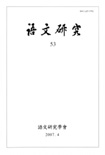- 영문명
- A Study on the Anonymous poets in Chungguyoungun, the Collection of Sijo Poems
- 발행기관
- 어문연구학회
- 저자명
- 남정희(Jeong-Hee Nam)
- 간행물 정보
- 『어문연구』語文硏究 第53輯, 125~154쪽, 전체 30쪽
- 주제분류
- 어문학 > 한국어와문학
- 파일형태
- 발행일자
- 2007.04.30

국문 초록
영문 초록
This thesis is focused on the anonymous poets who had lost their name and only their works were handed down in collection of Sijo poems of the 18th century. The aim of this study is to contemplate the texture of sentiment that was brought out in Sijo created by the anonymous poets. These poems were all attached to the Yisakdaeyup, the main chapter of Chungguyoungun.
To succeed that analysis, I examined thoroughly fragmentary informations from written documents, like various collections of Sijo poems about the anonymous poets. In conclusion, they were not homogeneous poets of class, but heterogeneous poets of class who were liberal intellectuals, rich bureaucrats, gisaengs and the middle-class singers. They all had elegant taste of the Sijo music and enjoyed song in an atmosphere of freedom more than past. Those times, Sijo as poem had weakened its position between the appreciators in the space for its performance but, Sijo as song were wide spreaded and sung.
In process of that, many Sijo works have lost those creator"s name and the authorship of writing a lyric had weakened. The appreciators and special singers of Sijo took in poems of unknown poets naturally, because those suited to their taste. That literal tendency means that in the 18th century people who appreciated the Sijo in all kinds of class recognized it with art just expressing humane emotion and they didn"t have any intention to maintain Confucian normative view of art.
To succeed that analysis, I examined thoroughly fragmentary informations from written documents, like various collections of Sijo poems about the anonymous poets. In conclusion, they were not homogeneous poets of class, but heterogeneous poets of class who were liberal intellectuals, rich bureaucrats, gisaengs and the middle-class singers. They all had elegant taste of the Sijo music and enjoyed song in an atmosphere of freedom more than past. Those times, Sijo as poem had weakened its position between the appreciators in the space for its performance but, Sijo as song were wide spreaded and sung.
In process of that, many Sijo works have lost those creator"s name and the authorship of writing a lyric had weakened. The appreciators and special singers of Sijo took in poems of unknown poets naturally, because those suited to their taste. That literal tendency means that in the 18th century people who appreciated the Sijo in all kinds of class recognized it with art just expressing humane emotion and they didn"t have any intention to maintain Confucian normative view of art.
목차
1. 문제 제기
2. 이삭대엽의 틀 안에서 무명씨 소작의 내용
3. 가집 내 무명씨 실체에 대한 흔적 검토
4. 작가의 다층적 성격과 무명씨화의 전개
5. 시조사적 맥락에서 무명씨화의 의미
6. 맺음말
참고문헌
Abstract
2. 이삭대엽의 틀 안에서 무명씨 소작의 내용
3. 가집 내 무명씨 실체에 대한 흔적 검토
4. 작가의 다층적 성격과 무명씨화의 전개
5. 시조사적 맥락에서 무명씨화의 의미
6. 맺음말
참고문헌
Abstract
해당간행물 수록 논문
참고문헌
최근 이용한 논문
교보eBook 첫 방문을 환영 합니다!

신규가입 혜택 지급이 완료 되었습니다.
바로 사용 가능한 교보e캐시 1,000원 (유효기간 7일)
지금 바로 교보eBook의 다양한 콘텐츠를 이용해 보세요!


